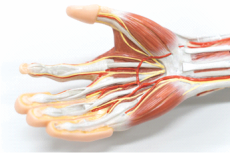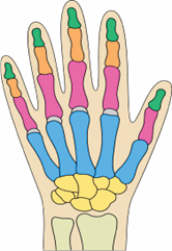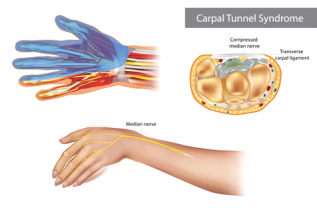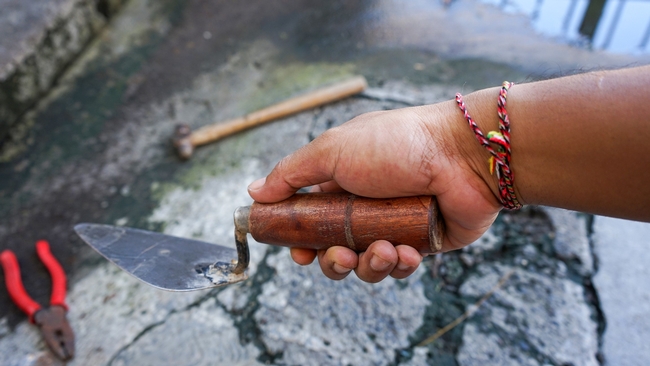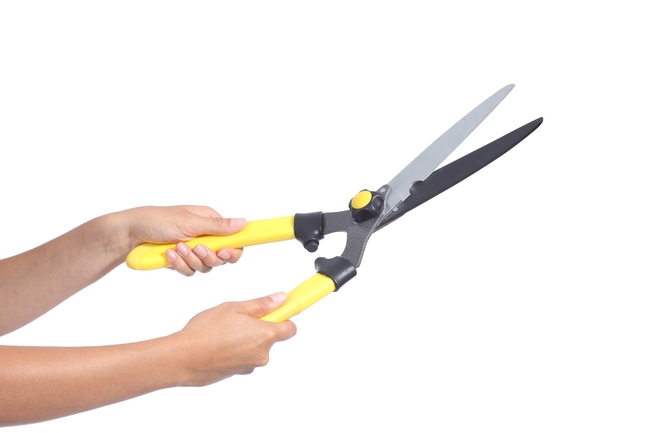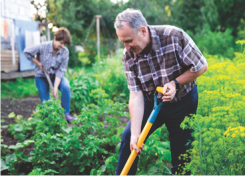by Bob Niklewicz PT MG.
Did you know fingernails grow faster on the hand a person writes with? They also grow faster than toenails, and faster on longer fingers. Our hands are wonderfully engineered structures that are under-appreciated by most people. They have been a major factor in the evolution of the human species.
Figure 1 shows the 27 bones of the hand and wrist. Figure 2 shows the relationship of the blood vessels, nerves and muscles in the hand. Except for a few of the muscles that are in the palm of the hand, the finger muscles start in the forearm. Figure 3 indicates where a person will feel pain or numbness when they suffer from Carpal Tunnel Syndrome (CTS).
Especially note the position of the wrist in Figure 4, 5 & 6 where it is bent downwards. Holding a tool in that position as well as bent downwards is a common posture causing trauma to the wrist.
Figure 6 shows, in spite of his smile, a man holding his right hand in a severely bent angle. His left hand is not on the handle correctly, pressing into the softest and most vulnerable place on the palm.
To get a “handle” on why these awkward hand postures are a problem is found in Figures 7 & 8. If you look at the numbers of Figure 7, the top it says “Neutral” and just below 0° and below that 100% of grip strength, the best and strongest position of your hand.
The right side of Figure 7 “Ulnar Deviation” means bending to the little finger side. When it moves 40° only 75% of your grip strength is available. The same thing happens in Figure 8 where downward (flexion) to 65° gives only 45% of maximum strength. Awkward positions force you to work harder at gripping a tool. More importantly, there is a greater chance to hurt the joints, nerves and tendons of your hand. Wearing gloves would protect your hands if they fit properly. Avoid the problem by positioning your hands correctly.
If you have an existing hand and/or wrist issue, or suspect one is starting, consider ergonomically engineered tools. Below are examples of tools that can reduce the risk of wrist injuries. They are available online or in larger box stores.
Figure 9 shows a cultivator with the handle set at 90° that allows the wrist to be in a neutral position. Figure 10 is the same cultivator, but with a forearm stabilizer for those with painful or weak wrists. Figure 11 shows a cultivator & stabilizer, a hoe with an additional hand grip attached to the handle of the hoe, and a trowel with a curved handle that places the wrist closer to a neutral position. Figure 12 is a pistol grip sprayer that allows the wrist to be in a neutral rather than a downward (ulnar deviated) posture that a straight nozzle would require.
Remember, your hands are so much a part of your life you may not give them the protection and respect they deserve. You do not have to hurt to have fun in the garden.
Napa Master Gardeners are available to answer garden questions by email: mastergardeners@countyofnapa.org. or phone at 707-253-4143. Volunteers will get back to you after they research answers to your questions.
Visit our website: napamg.ucanr.edu to find answers to all of your horticultural questions.
Photo credits: Figure 1: Vectorstock.com; figures 2-8 Dreamstime; figures 9-12 Bob Niklewicz
Information links:
UHSBerkeley.edu-ergonomics tips for gardening at home
https://uhs.berkeley.edu/sites/default/files/ergonomics_tips_for_gardening_at_home.pdf
